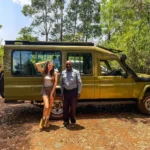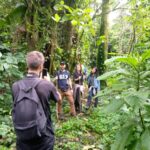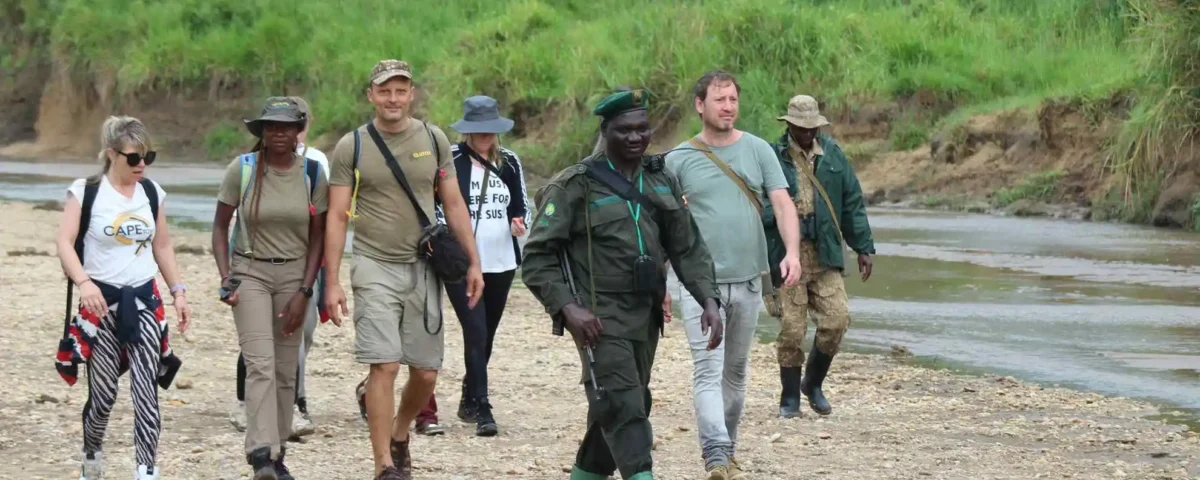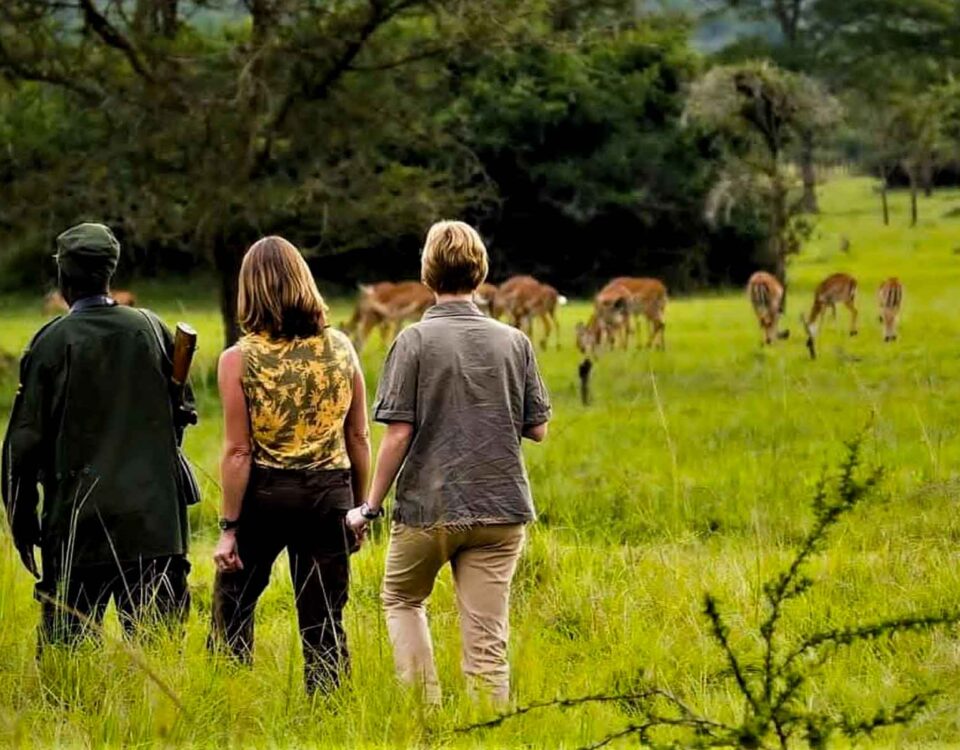
How Do I Book a Game Drive Safari in Uganda?
August 15, 2025
How Long Does a Walking Safari Last?
August 16, 2025What is a Walking Safari in Uganda?
Discovering Uganda’s Wild Heart on Foot
For many travelers, Uganda is synonymous with gorilla trekking and big game drives, but an often-overlooked treasure is the immersive experience of exploring the wilderness on foot. This leads many first-time visitors and seasoned adventurers to ask: What is a walking safari in Uganda? In the simplest terms, it is a guided nature walk through some of Uganda’s most pristine wildlife areas, offering an intimate connection to nature that vehicles cannot provide. But in truth, it is much more than a walk — it’s a sensory journey into the heart of the African bush.
Walking safaris bring you closer to the details of Uganda’s diverse ecosystems. From the fresh scent of morning dew on savannah grass to the distant calls of grey-crowned cranes, you become part of the living landscape rather than just an observer. Under the expert guidance of professional rangers, these safaris allow you to track animal footprints, identify bird calls, and understand plant life, all while learning the interconnected stories of wildlife and people.
For those considering Uganda Best Safaris, walking safaris can be seamlessly woven into itineraries that also include Uganda Gorilla Safaris, Uganda Wildlife Safaris, and even Uganda Cultural Safaris. Imagine spending one day face-to-face with elephants in Murchison Falls National Park on foot, and the next deep in Bwindi Impenetrable Forest on a gorilla trek. By answering What is a walking safari in Uganda?, travelers open the door to a world of slow-paced, deeply enriching adventures that bring unmatched authenticity to their African journey.
The Walking Safari Experience – Up Close with Uganda’s Wildlife
So, what is a walking safari in Uganda like in practice? Unlike game drives, where you cover large distances quickly, walking safaris are about slowing down and noticing the small but significant details that make Uganda’s landscapes so rich. Every step is deliberate, as guides point out fresh animal tracks, dung that reveals what species passed by, or plants that have traditional medicinal uses. This is the kind of Uganda Wildlife Safari experience where you might stand quietly as a herd of Uganda kob grazes just meters away or hear the rustle of a bush revealing a warthog family trotting into the undergrowth.
In Murchison Falls National Park, walking safaris often take place in designated safe zones, where big game is present but manageable under ranger supervision. In other parks, such as Lake Mburo National Park, travelers can walk among giraffes, zebras, and antelope without the barrier of a vehicle. These encounters feel more personal and often more thrilling, as the ground-level perspective heightens the sense of adventure.
For bird enthusiasts wondering what is a walking safari in Uganda in terms of birdwatching potential, the answer is excellent — Uganda Birding Safaris benefit enormously from this approach. On foot, you can quietly approach forest edges and wetlands where rare species like the shoebill stork, African finfoot, or great blue turaco reside. This makes walking safaris a must-try for anyone crafting Uganda Best Safaris that value both large game and avian life.
Combining Walking Safaris with Gorilla Trekking – The Ultimate Itinerary
If you’re asking what is a walking safari in Uganda and whether it can be combined with gorilla trekking, the answer is a resounding yes. In fact, this combination is one of the most rewarding experiences available in East Africa. While walking safaris offer close encounters with plains game, birds, and smaller creatures, Uganda Gorilla Trekking Safaris immerse you in dense, mist-shrouded forests where the world’s last remaining mountain gorillas live.
An ideal itinerary might begin in Murchison Falls National Park or Lake Mburo for walking safaris, followed by chimpanzee tracking in Kibale Forest — another excellent on-foot adventure — before heading to Bwindi Impenetrable National Park for gorilla trekking. This way, travelers experience Uganda’s wildlife across multiple ecosystems, from open savannah to tropical rainforest. The walking safari prepares you physically for the endurance of gorilla trekking while mentally attuning you to spotting subtle wildlife signs.
This pairing also makes sense for photographers. A walking safari in the savannah offers wide-angle shots of landscapes and herds, while gorilla trekking delivers intimate portraits of primates. By combining these experiences, travelers create what many call Uganda Best Safaris, blending diversity, adventure, and depth. So, when considering what is a walking safari in Uganda, think of it not just as a standalone activity but as a perfect complement to other iconic adventures.
Cultural Encounters on Foot – Adding Depth to Walking Safaris
For culturally curious travelers asking what is a walking safari in Uganda in relation to meeting local communities, the experience can be far richer than expected. Walking safaris often extend beyond wildlife zones into nearby villages, where visitors can engage directly with Uganda’s cultural heritage. In areas surrounding Murchison Falls and Lake Mburo, for example, guided walks can be combined with visits to fishing communities, cattle-herding settlements, or artisan groups.
These Uganda Cultural Safaris offer authentic insights into daily life. You might join a family in preparing a traditional meal, watch women craft intricate beadwork, or learn drumming rhythms that have been passed down for generations. This human connection brings context to the landscapes and wildlife, showing how people and nature coexist. For many, it becomes a highlight equal to spotting a lion or elephant.
Moreover, walking to these communities creates a gradual transition between wild and human environments, deepening the sense of place. It also supports sustainable tourism, as fees and purchases directly benefit local people. Travelers on Uganda Gorilla Safaris can easily integrate such cultural encounters between treks, enriching their journey. Therefore, when answering what is a walking safari in Uganda, it’s important to remember it’s not just about the animals—it’s about stepping into the heartbeat of the land and its people.
Walking Safaris for Birding Enthusiasts – The Joy of Slower Travel
If you love birds and wonder what is a walking safari in Uganda from an ornithological perspective, it is perhaps the best way to spot species that might be missed on a fast-moving game drive. Walking allows you to move quietly into bird-rich habitats, pause to listen for calls, and observe behaviors without disturbance.
In Murchison Falls National Park, walking along riverine forests can reveal sightings of the pied kingfisher, giant kingfisher, and African jacana. In Queen Elizabeth National Park’s Maramagambo Forest, guided walks offer chances to spot the black bee-eater and white-naped pigeon. Lake Mburo is also a paradise for Uganda Birding Safaris, with species such as the red-faced barbet and African finfoot visible only to patient observers.
Combining walking safaris with Uganda Wildlife Safaris means you don’t have to choose between big game and birding — you can enjoy both in the same trip. Adding Uganda Chimpanzee Safaris in Kibale Forest further enriches the experience, as primate-rich forests are also hotspots for diverse birdlife. So, for those seeking Uganda Best Safaris, the walking safari is the bridge between large mammal encounters and avian treasures, making the answer to what is a walking safari in Uganda clear: it is an opportunity to slow down and see more.
Why Choose a Walking Safari? – Benefits for Travelers
Many travelers who ask what is a walking safari in Uganda are surprised at how much it changes their perspective on wildlife travel. Being on foot fosters a sense of vulnerability and respect for nature that vehicles can’t replicate. Every sound becomes more distinct, every movement more significant. You’re no longer just a spectator — you’re part of the environment.
Walking safaris also promote physical activity and mindfulness, making them ideal for travelers who want more than passive sightseeing. The slower pace allows for better photography opportunities, more meaningful guide interactions, and deeper appreciation of Uganda’s biodiversity. It’s also a more eco-friendly form of exploration, leaving a lighter footprint compared to vehicle-based safaris.
For those designing Uganda Best Safaris, walking safaris add variety and balance. They complement high-energy adventures like gorilla trekking and chimpanzee tracking, as well as cultural excursions. This mix ensures that the answer to what is a walking safari in Uganda is not only about the activity itself but about the transformative effect it has on your entire journey.


